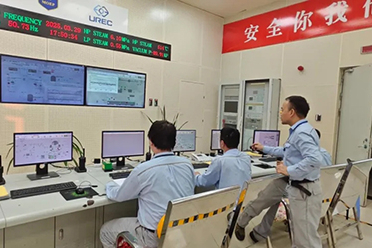
POWERCHINA's maintenance team of the 110 MW Thaketa Gas-Steam Combined Cycle Power Plant.
A 7.9-magnitude earthquake hit Myanmar on March 28, severely damaging power grid facilities across the country. POWERCHINA's maintenance team for the 110 MW Thaketa Gas-Steam Combined Cycle Power Plant in Yangon, Myanmar, swiftly activated its emergency plan and, after nearly 16 hours of continuous efforts, successfully restored power at 4:10 am the following day.
This rapid recovery provided crucial electricity support for post-disaster relief and people's livelihoods, earning high praise from Myanmar's Ministry of Electricity and the project owner.
The power plant, a key energy project in the country undertaken by POWERCHINA, faced a critical situation when the power grid collapsed, triggering unit shutdowns and a complete power outage at the plant.
In response to the sudden disaster, POWERCHINA immediately activated the Level-1 emergency mechanism. Operators swiftly isolated faulty equipment and started the backup diesel generator to ensure an uninterrupted power supply for the plant's security section. The safety team urgently evacuated all personnel from office buildings and dormitories to an open basketball court, conducted a headcount, and checked for injuries.
Meanwhile, the maintenance and operations teams carried out a thorough inspection of critical facilities, including natural gas pipelines, the circulating water system, and pumps, to prevent secondary disasters such as leaks or structural shifts.
The entire process from the power outage to initial situation control took less than 30 minutes. Repeated emergency drills and well-coordinated personnel deployment played a crucial role in securing valuable time for the repair efforts.
Although the power plant's internal equipment quickly stabilized, the restoration of the national power grid progressed much slower than expected. POWERCHINA maintained real-time communication with Myanmar's power dispatch center, remaining on standby to reconnect to the grid at any moment.
However, during the night's restoration efforts, Myanmar's power system suffered two complete grid collapses and a severe frequency fluctuation, causing multiple unit trips during the startup phase.
Faced with the extreme instability of Myanmar's grid, POWERCHINA adopted a "small steps, fast progress" strategy. During brief grid recovery windows, employees restarted equipment in batches. At the first sign of abnormal voltage or frequency, they immediately executed protective shutdowns to prevent damage to equipment. Throughout the emergency repairs, project leaders and operators remained stationed in the central control room overnight, manually adjusting hundreds of parameters to ensure the units remained in a safe state despite repeated start-stop cycles.
At 3:33 am on March 29, following the preliminary restoration of the main power grid, the plant's units were successfully connected to the grid. However, frequent aftershocks continued to disrupt the grid, causing voltage and frequency to fluctuate wildly between 48Hz and 51.9Hz.
In response, POWERCHINA swiftly transitioned into "wartime monitoring" mode, dynamically adjusting power generation output based on system frequency. By adopting a flexible power supply strategy, they maximized grid adaptability while ensuring stable operations.
The power plant ultimately shouldered 30 percent of Yangon's emergency post-earthquake power load, providing critical electricity support for medical relief, communication bases, and water supply systems in disaster-stricken areas.
POWERCHINA is still on high-alert 24-hour emergency power supply mode, implementing a rotating shift system across all technical teams to ensure preparedness for potential aftershocks.
As the project manager of the operation and maintenance department put it: "Every light that turns on in the disaster zone is our contribution to life."
The Thaketa Gas-Steam Combined Cycle Power Plant is a key energy project under the Belt and Road Initiative. On Feb 28, 2018, the power plant achieved combined cycle power generation ahead of schedule, passing the full-plant performance assessment in one go with excellent indicators.
For the past six years straight, it has exceeded its annual power generation targets and repeatedly set new records for electricity output. The project has played a crucial role in alleviating local power shortages and driving regional economic and social development.